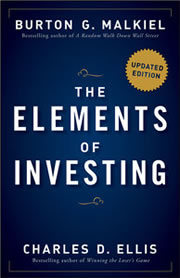There are two major types of investing books for beginner investors: “Instructional to-do list” books basically tell you what you should do. “Inspirational big-picture” focus more on the philosophical reasons why you should do those things. Both can be equally important and useful.
The Elements of Investing: Easy Lessons for Every Investor by Burton G. Malkiel and Charles D. Ellis falls more into the former “list” category. Malkiel is a noted academic and wrote the classic bestseller A Random Walk Down Wall Street. Ellis is a former director of Vanguard Group and wrote the classic bestseller Winning the Loser’s Game.
Basically, two pillars of the investment world got together and tried to whittle down their 80 years of experience into 200 pages and roughly 2-3 hours of reading time. The pages aren’t even big, as the hardcover version is only 7 inches tall. You could read the entire thing in an afternoon or in snippets before going to bed within a week.
In opinion, they did a pretty good job. Topics are covered in a brief, straighforward manner. If you’ve read your share of personal finance material, none of it will be new to you, but they remain critically important. The key takeaways are clearly laid out and repeated over and over to drill them into your head. Things like:
- Save regularly and never take on credit card debt (most important).
- Utilize any available tax-advantaged plans like IRAs, 401ks, 403bs.
- Keep a safe, liquid emergency fund.
- Diversification, rebalancing, dollar-cost averaging, and low-cost indexing are the keys to investing success.
There are also a lot of little nuggets of wisdom in the book. My two favorite quotes:
The real purpose of saving is to empower you to keep your priorities—not to make you sacrifice. Your goal in saving is not to “squeeze orange juice from a turnip” or to make you feel deprived. Not at all! Your goal is to enable you to feel better and better about your life and the way you are living it by making your own best-for-you choices. Savings can give you an opportunity to take advantage of attractive future opportunities that are important to you.
As in so many human endeavors, the secrets to success are patience, persistence, and minimizing mistakes.
The updated 2013 edition of the book (original edition was 2009) includes some interesting (controversial?) suggestions for dealing with the current low-interest environment for bonds. Since the current yield for US Treasury bonds is so low, and thus the future expected return just as low, they offer up tax-exempt municipal bonds, emerging markets bonds, and even blue-chip dividend stocks.
It was sort of weird to be told “stay the course!” and then in the next chapter be told “here’s how to change course!”. I actually appreciate that they express their honest opinions, even if it appears to contradict passive-investing dogma. Jack Bogle himself does it from time to time. (I personally choose to hold muni bonds instead of US Treasuries as well.)
Bottom line: This investing primer would make a very good gift for a recent college graduate or young worker if they are ready to start getting serious about investing. If they aren’t, the book may be a bit dry. I will be adding it to my recommended books list, once I get around to updating it…

 The Best Credit Card Bonus Offers – 2025
The Best Credit Card Bonus Offers – 2025 Big List of Free Stocks from Brokerage Apps
Big List of Free Stocks from Brokerage Apps Best Interest Rates on Cash - 2025
Best Interest Rates on Cash - 2025 Free Credit Scores x 3 + Free Credit Monitoring
Free Credit Scores x 3 + Free Credit Monitoring Best No Fee 0% APR Balance Transfer Offers
Best No Fee 0% APR Balance Transfer Offers Little-Known Cellular Data Plans That Can Save Big Money
Little-Known Cellular Data Plans That Can Save Big Money How To Haggle Your Cable or Direct TV Bill
How To Haggle Your Cable or Direct TV Bill Big List of Free Consumer Data Reports (Credit, Rent, Work)
Big List of Free Consumer Data Reports (Credit, Rent, Work)
Question: does it explain the basics of “Diversification, rebalancing, dollar-cost averaging, and low-cost indexing “…while I put into my 401k, i feel like it’s growing at a horrible rate (I have an old 401k that averaged 1.5% last year!) so I need to learn more about what these things are. Thanks!